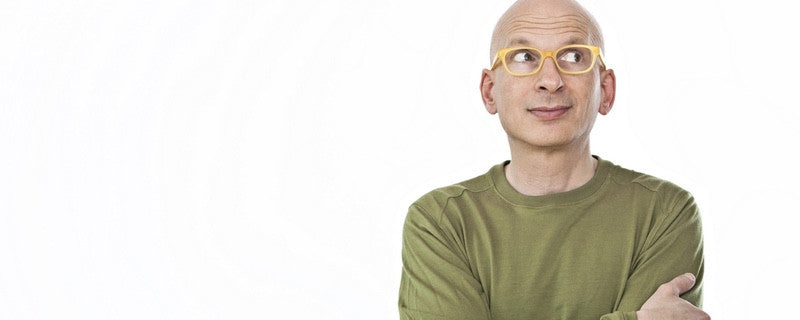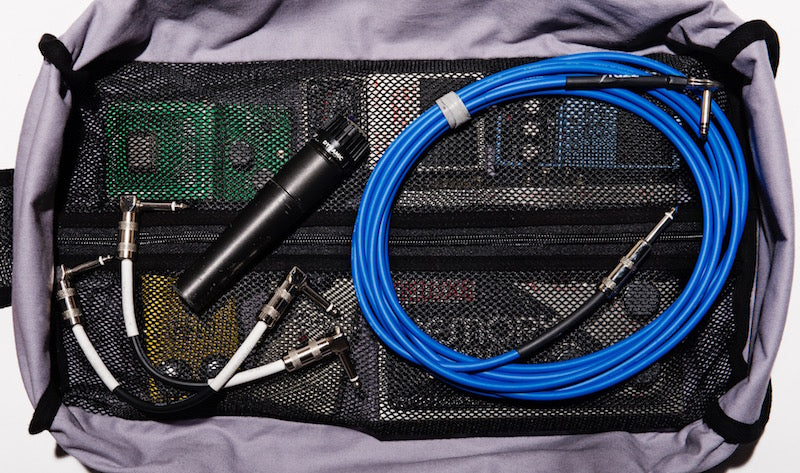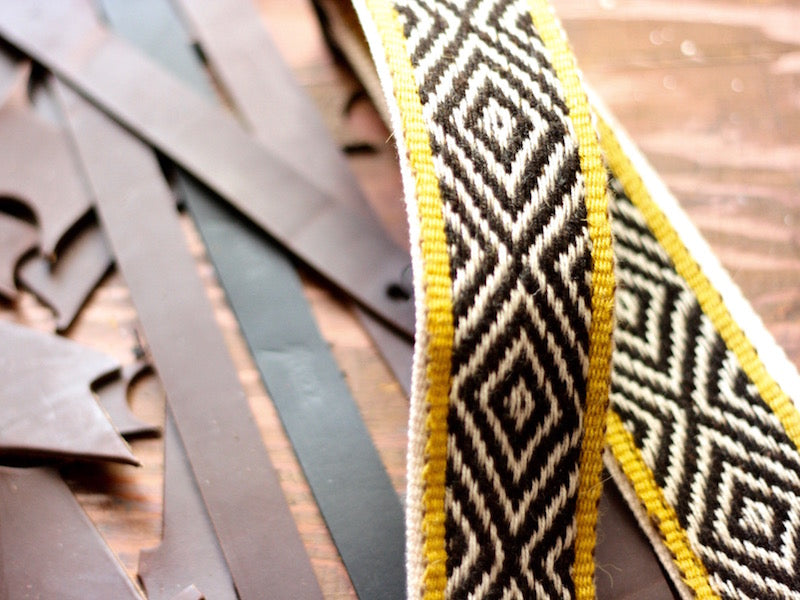
How We Talk About Our Project
Seth Godin put out another thought-provoking blog post this morning called “How to talk about your project.” When he says, “talk about your project,” he means, “not in a marketing sense, but strategically, to yourself, your partners, your coaches, your investors…Successful project organizers are delighted to engage in a conversation about all of these questions. If you're hiding from them, it's time to find out why.”
If you don’t know Seth’s work, check it out. I’ve probably read every post he’s written for the last ten years. Because he called me out today, I figured I shouldn’t hide. So I answered his questions. Here’s how we talk about Original Fuzz.
What is it for? When someone hires your product or service, what are they hiring it to do?
We make inspired gear for creative pioneers. You hire our products if you want the accessories that you use to do your creative work to be just as inspiring as the other tools in your kit. So, if you’re a guitar player, not only should you play a guitar that feels great and inspires you, you should use a strap that makes you feel cool. Creative people understand that their tools matter.
As we grow we hope to expand to other creative fields. We strive to be a “Patagonia for creative people.” Patagonia started with climbers. We started with guitar players, but stay tuned. We’ll soon be branching out into photographers, chefs, artists, designers, hackers, filmmakers, inventors, writers, entrepreneurs, and more. Music will always be at our core, but it’s just the beginning. Inspired gear for creative pioneers. Made in Nashville.
Who (or what) are you trying to change by doing this work? From what to what?
This one is a really good question. It goes right to the heart of any business. It’s that slide on a Y Combinator pitch deck that explains “the problem” a company is trying to solve.
When we started Original Fuzz we were trying to solve a very niche problem that my co-founder Zach and I had: we liked to carry our guitar pedals around in a gym bag, but there was no protection inside a gym bag to organize things and hold the electronics. So we scratched our own itch and designed the Fuzz Bag. Then, Zach took a trip to Peru and saw the gorgeous handwoven belts that are a part of that country’s culture. He realized this would be a great material to use in a guitar strap, so we started making guitar straps.

Then we realized the problem is much broader. There’s this huge music-products industry that places value on the aesthetics and design of instruments and electronics, but all of the other gear gets left behind. It’s a world full of cheap, black, plastic stuff. So we set out to change that. And it doesn’t just apply to the music industry. A lot of bags, straps, cases, and other accessories that creative people use to travel, protect, and organize their gear is uninspiring. It doesn’t have to be that way.
How will you know if it's working?
To be honest, the only metric that matters is sales growth. The market doesn’t lie and I think this is the most important metric for measuring whether or not people want your product or service. In the two years that we’ve been doing this, we’ve been happy with our growth and have been beating our internal goals, so I’d say it’s working.
Other than sales, we also constantly ask our customers to share their feedback. We pretty much only hear positive comments about the quality of our products. But there’s one complaint that we hear a lot: our products are too expensive. (I’ll address that feedback in a later question). My concern with this is that we’re not hearing enough from the people that choose not to buy from us. That’s something I want to work on this year.
What does it remind me of? Are there parallels, similar projects, things like this that have come before?
I touched on this earlier, but we want to be “Patagonia for creative people.” What Patagonia is to outdoor adventurers and travelers, we want to be to creative adventurers and travelers. Hence the phrase in our tagline, “creative pioneers.”
What's the difficult part?
What isn’t the difficult part?
The key thing that we struggle with is delivering a high-quality product and using interesting, responsibly-sourced raw materials at a price point that the market demands. We’ve made some progress with our repurposed seatbelt straps, but we’re not there yet.

As we talk to customers we continue to hear that our products are too expensive. But doesn’t every business? Wouldn’t every customer always like to pay less for everything? It’s also sort of a catch-22 for us. In order to make something different with a higher build quality, we’ve had to do things differently and use expensive raw materials. Our costs are higher than our competitors. It takes a long time to weave a Peruvian guitar strap by hand. So, we’re still working on new products with integrity that hit the pricing sweet spot.
Now, I’m speaking to the guitar strap market. Another way to solve this problem would be to branch out into other markets that are less-price sensitive. Perhaps photographers are not as price sensitive as guitar players? But that’s just a theory. We already know a lot about selling guitar straps. In the near term, I believe we need to focus on that core product and audience until we are the best guitar strap company in the world.

How much of your time and focus are you spending on the difficult part?
Not enough. Damn, calling me out Seth! Honestly, as founder of the company I probably spend 90% of my time on other things. You’re holding a big mirror in my face.
What part that isn't under your control has to happen for this to work? (Do you need to be lucky?)
There are two key things here that I think we have faith in that are not in our control–the direction that technology is heading during our lifetime and our ability to satisfy consumer aesthetic preferences.
We believe that connecting to our audience directly through the internet will continue to be the way to do business in the future. And it will only grow in importance over the next 50 years. But we can’t control how technology changes. We have to stay current and do our best to adjust. A great example is how we’re not doing enough on Snapchat, but it’s grabbing a huge share of attention from young people.
Also, we can’t control design trends and tastes. I think we can only focus on our own process, make things that we believe in, and hope that what we design resonates. But tastes, trends, consumer spending habits are largely out of our control. We have to try to follow them while maintaining integrity. (Also known as “not selling out.”)
How much (time and money) is it going to take to find out if you've got a shot at this working out?
We’ve sort of passed the initial version of this and proven that we have a viable business, market for our products, and foundational customer base. But we’re very a small company. This year is a pivotal moment for us. We need to solve our most difficult problem–reaching product/market fit with products that can be priced the way the market wants it to be priced, or we’re going to stagnate this year. I’d say it will take us until the end of the year (and the runway needed to get there) to see if we can reach the next level.
What assets do you already own that you'll be able to leverage?
We’ve built a core audience and brand with some great wholesale partners and people that follow this blog, our magazine, our podcast, and social media. We have the organizational capacity to make everything in the US in our Nashville workshop.
What assets do you need to acquire?
We need to build a bigger audience by providing more value to our core audience. This means creating more products and content that they actually want to buy, read, watch, and listen to. We need to build better manufacturing processes so that we can more efficiently serve this audience’s needs. We also have some large equipment investments that we need to make this year as well.
After the project launches, what new assets will you now own?
It’s been over two years since we launched, so it’s really more about growth at this phase. We need to get to a level of sustainability so that this can be a long term business. One that can last for decades. One thing that I believe is helping is that we have one single goal across the entire company for this year. Projects and priorities are changing on a daily basis, but we all know what will define success in 2016. You can only have so many priorities and the simplicity of a single goal is really helping us this year.
From which people will you need help? Do they have a track record of helping people like you?
We need help from our employees, the community here in Nashville, and the larger Internet community of bloggers and social media influencers. I’d say we do have a strong track record of receiving help, so we want to continue this and find ways to give back to the community.
Is it worth it?
Absolutely. Because we make products like we give a damn, this gets passed on to the customer. If we do our job well our products will make people’s lives better. I know that sounds a idealistic, but that’s the point of design. If you are making anything–a chair, a screwdriver, a guitar strap, whatever–it should do a job that improves someone’s life. And it’s not all about usefulness either. Beauty and aesthetic pleasure are valuable. So yeah, if we put out products that do this for people it’s worth it, and I believe we'll have a business built for the long-haul. It also helps ensure that the objects we make get passed on to others and don’t end up in a landfill.
